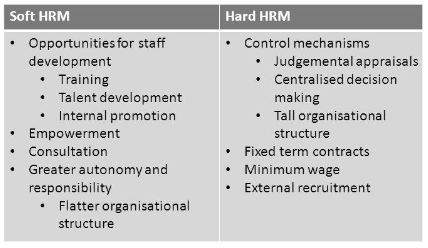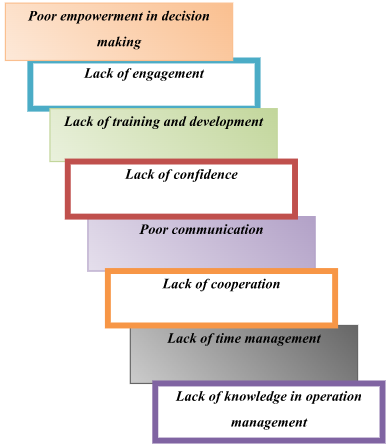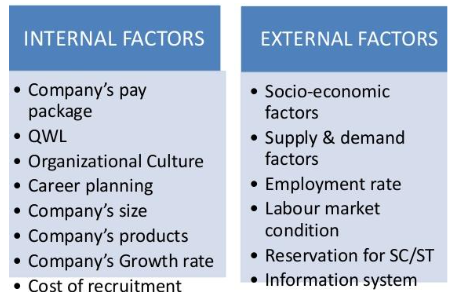Evaluate the role of HRM
Introduction
Managing human resource is a critical task for the organisations as it needs proper strategies to handle the employees and retain them for long run (Cascio, 2018). As the employees are the main stakeholders of the company in maximising organisational performance and achieving pre-specified objectives of the companies, it is the responsibility of the manager to manage the employees or team members in order to lead the members towards achieving success. The aim of the study is to understand the current situation in the successful subsidiary of Pierre Voisinet so that it is possible to identify the current issue in managing the team members as well as recommend some suitable suggestions for future growth.
Evaluate the role of HRM
The human resource management (HRM) is crucial approach for all the competitive firms operating in the international market in order to build strong relationship between the managers and the employees so that it is possible to retain the employees for long run (Bratton and Gold, 2017). Through the approach to human resource management, the companies can manage the performance of the organisation as a whole and secure future sustainable development by gaining high competitive advantage and improving market share of the brand (Hollenbeck and Jamieson, 2015).
Approach of human resource development

Human resource management is also important in this regard to improve collaboration and communication among the team members so that it is possible to share information among the team members and develop harmony where all the team members can cooperate with each other for meeting the common pre-specified team objective (Armstrong and Taylor, 2014). The management team in this regard aims at empowering the employees in the decision making process as well as provide greater autonomy and responsibility to the team members so that the employees can feel valued and become more responsible for doing their job role efficiently.
Providing performance related pay, incentives and attractive rewards to the employees are also another approach for satisfying the employees so that the members can meet their basic needs (Hollenbeck and Jamieson, 2015). Term contract and employment laws are also effective to be maintained in order to improve job security of the employees. Moreover, the management team tries to provide effective induction process as well as arrange training and development for the employees so that they can improve their skills and knowledge which further helps them for their personal development (Chelladurai and Kerwin, 2017). These approaches to human resource management are beneficial for the organisations to satisfy the team members and manage them for long run.
In the recent case study of Pierre, the team members face some issues for which the organisation cannot performance well. It is hereby necessary to resolve the existing issues so that the team members can improve the overall performance of the organisation as well as maximise the organisational goals. The issues are discussed further,
Issues of managing human resource

In the group, there are Pierre Voisinet, Michel, Aldo, Stephanie, Jan and John and there are certain issues in the team for which the organisational performance cannot be maximised. The main issue is lack of communication and cooperation. Due to lack of open discussion, general meeting and discussion, the employees cannot communication with each other which further increases the issue where the team member can share ideas and views openly. This further leads to non-cooperation where they cannot collaborate properly in order to meet the organisational objectives (Hollenbeck and Jamieson, 2015). Lack of knowledge and technical skill of operation management further raise the issue of proficiency in managing the organisational operations as well as time management (Chelladurai and Kerwin, 2017).
In addition to these, lack of confidence and poor empowerment of the employees in the decision making practice of the organisation also raise difficulties to manage the team members. Moreover, there is lack of engagement among the employees which is also another crucial issue in the organisation for which the manager fails to build strong corporate relationship with other team members (Chelladurai and Kerwin, 2017). In addition to these, lack of training and development is another serious issue for which the organisational performance is deteriorating where the team members have poor knowledge and understanding regarding the operational activities of the organisation. These issues must be addressed so that it is possible to manage the team members and maximise the organisational performance. Discover additional insights on Human Resource management issue by navigating to our other resources hub.
Analysis of external and internal factors, including current ethical debate
There are many internal and external factors that have crucial impacts on the management practice of human resource. In this regard, the economic factors are such as population and workforce, market condition, inflation rate in the economy and the salary structure and in this regard, the organisations need to manage minimum wage for the team members to retain them for long run. As per the legal factors, the Pierre’s team need to be concerned about the rules and legislations in the industry, no discrimination practice in the organisation as well as health and safety in the workplace. The legal factors need to be considered in the human resource management (Armstrong and Taylor, 2014).
Environmental factors affecting HRM

Without legal consideration, the companies cannot handle the team members and in this regard, proper organisational culture, legal employment laws as well as health and safety in the workplace need to be maintained (Chelladurai and Kerwin, 2017). The social cultural environment is also necessary to be maintained where the managers need to be concerned about the achievements of the employee’s workforce mobility freedom to work as well as employee’s personal development so that it is easy to encourage the employees in long run (Hollenbeck and Jamieson, 2015).
External and internal factors affecting HRM

The internal factors include company’s pay package, cost of recruitment, organisational culture, the products and size of the company and growth rate of the organisation. These factors also have crucial impacts on the Pierre’s team where Pierre needs to be concerned regarding the pay structure and other incentives the team members in order to encourage them in the workplace (Armstrong and Taylor, 2014). On the other hand, the external factors are socio economic factors which have been discussed previously and apart from that the labour market condition, reservation and technological advancement which also have serious effects on the human resource management.
The major ethical issues may be increased in the workplace which is such as organisational culture, low wage rate, lack of safety in the workplace, absence of harmony and freedom to work as well as discrimination and cultural diversity (Marchington et al., 2016). These issues are serious where the employees are not willing to cooperate with each other and they fail to communicate in the workplace which hampers the organisational performance. In this regard, the ethical issues in the Pierre’s team need to be addressed properly and Pierre must focus on develop strategic planning for managing all the team members to enhance the overall organisational performance.
Explain the role of line managers to achieve high performance
The line manager plays an important role in the organisation in managing the team members and enhancing the performance of the companies. The line manager tries to reallocate the employees and provide proper instruction regarding the actual job description of the individual in the workplace (Reiche et al., 2016). Hereby, the line manager is responsible for monitoring the progress of the employees and enhancing creativity and innovation in the workplace of smooth working relationship. Developing the abilities of each person working in the team through innovation and encouraging the employee’s creativity is also the role of the line manager.
>Role of line manager

Protecting the health and safety in the workplace ad restricting the payroll and incentive are also the responsibility of the line manager where the manager is concerned about motivating the employees in the workplace so that they can contribute with their full potential to maximise the organisational objectives. In this regard, there is proper linkage among the good HRM practice, high performance of the company and organisational success (Brewster, Chung and Sparrow, 2016). Good managerial practice helps the manager to encourage the employees and maximise the requirements of the employees so that they feel satisfied in the organisation. This further motivates the team members to contribute 100% in order to achieve
the organisational goal creatively. Positive contribution and utilising organisation resources are helpful to enhance the performance of the employees and it further provides a scope to the managers and the employees to achieve the organisational success (Hollenbeck and Jamieson, 2015). Hereby, there is appropriate links among the good human resource management practice, organisational success and the performance of the team members. Through managing the human resource in the workplace, the managers can improve their performance ion long run and it further helps in achieving the organisational goals and objectives successfully (Jackson, Schuler and Jiang, 2014).
Recommendations
Considering the tools and approach of human resource management, it can be concluded that, human resource management is necessary to enhance the organisational performance. In this regard, Pierre needs to develop effective strategic planning for encouraging the team members so that it is possible to enhance the overall performance of the team and it is easy to meet the organisational strategic objective. Firstly, Pierre needs to arrange effective training and development program through which it is possible to improve the knowledge and technical skill of the team members. Without proper induction process as well as training program the team members cannot do the organisational job efficiently. Proper training and development in this regard is effective tactics for encouraging the employees and improving their participation. Training and development in the workplace also provides an opportunity to the team members to share their views and ideas which further help the manager to meet the strategic objective successfully.
Secondly, it is necessary to enhance internal communication where the team members can interact with each other, for improving verbal communication, the team members need to encourage open discussion with each other as well as arrange general meeting so that everybody in the team can interact with others. On the other hand, in order to improve non-verbal communication in the workplace the team members need to send personalise email for official purpose as well as utilise the technological advancement through implementing the Information and Communication technology (ICT) in the workplace. Both the verbal and non-verbal communication is necessary in the Pierre’s team to manage their performance and encourage all the team members successfully. Communication and interaction further enhances the cooperation and collaboration in the team which further raise the interest of the team members to contribute positively for meeting the organisational objectives.
Thirdly, Pierre needs to empower the team members in the decision making practice so that the interest of participation in organisational decision making process among the team members can be increased. Through managing organisational culture, positive attitude towards each other and effective empowerment of the members in the decision making practice are helpful to enhance the performance of the organisation. In addition to these, maintaining transparency and accountability in the team also encourage the participation of the team members in the decision making process. Through empowering, the manager can get different innovative views and ideas from team members where the team members are also becoming interested in sharing their creative thoughts to do their job with more creativity. Through these strategic planning, Pierre can manage the team members and resolve the existing issues in the team. The above mentioned recommendations are also effective for enhancing the performance of the team as a whole. Proper cooperation and improved communication are beneficial to encourage the team members and build strong corporate relationship with each other.
Reference List
- Armstrong, M. and Taylor, S., 2014. Armstrong's handbook of human resource management practice. London: Kogan Page Publishers.
- Bratton, J. and Gold, J., 2017. Human resource management: theory and practice. London: Palgrave.
- Brewster, C., 2017. The integration of human resource management and corporate strategy. London: Routledge.
- Brewster, C., Chung, C. and Sparrow, P., 2016. Globalizing human resource management. London: Routledge.
- Cascio, W., 2018. Managing human resources. London: McGraw-Hill Education.
- Chelladurai, P. and Kerwin, S., 2017. Human resource management in sport and recreation. London: Human Kinetics.
- Hollenbeck, J.R. and Jamieson, B.B., 2015. Human capital, social capital, and social network analysis: Implications for strategic human resource management. The Academy of Management Perspectives, 29(3), pp.370-385.
- Jackson, S.E., Schuler, R.S. and Jiang, K., 2014. An aspirational framework for strategic human resource management. The Academy of Management Annals, 8(1), pp.1-56.
- Marchington, M., Wilkinson, A., Donnelly, R. and Kynighou, A., 2016. Human resource management at work. London: Kogan Page Publishers.
- Reiche, B.S., Stahl, G.K., Mendenhall, M.E. and Oddou, G.R., 2016. Readings and cases in international human resource management. London: Taylor & Francis.
